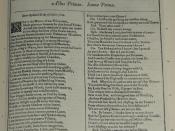It is difficult to fully comprehend the idea of malice. Some might say that a human can only truly comprehend malice if they experience it first. Dictionary.com defines malice as:
1.A desire to harm others or to see others suffer; extreme ill will or spite.
2.The intent, without just cause or reason, to commit a wrongful act that will result in harm to another.
As we have talked about in class and in most literature critiques, Richard III is clearly an evil, jealous, ambitious and (foremost) malicious man. Eve Shapiro (the director of the play) tried to portray the maliciousness of Richard III by developing a minimalist interpretation of the play; however, she failed because malice is a complicated idea.
The director tried to illustrate that malice in human affairs is very simple and pure. This was shown clearly throughout the performance. First of all, the very making of the performance was simple.
The lead actor that the director picked (Spencer Aste) was a very flamboyant and vivacious Richard III. He limbed as if his leg was broken, held his arm as close to his chest as possible and hunched like there were a thousand pounds on his back. This almost elicited sympathetic emotions from the audience. Moreover, the acting company was armed with ornate costumes, a surround-sound system and an underutilized but evocative portable lighting system consisting of seven rolling, vertical banks of four bulbs each. These, and daggers by the "back-full." There was no set to speak of, so at the core there were actors and their words, which is the way it was once meant to be (Moore). This simplicity brought forth the command of language that Shakespeare had at his disposal. The use of lighting was innovative and avant-garde (at least to the...



This was sweet
u inspired me to write better stuff
1 out of 1 people found this comment useful.